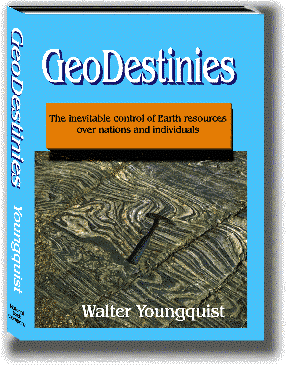The inevitable control of Earth resources over nations and individuals


SOCIOLOGISTS: Mineral and energy sources and supplies determine lifestyles and support social structures of societies. Societies built on non-renewable resources have a tenuous future. Important social legacies are left from mineral exploitation.
GEOLOGISTS: Where is the search for energy and minerals today? How is the world Earth resource base changing? What new roles will alternative energy sources play?
ECOLOGISTS: The environmental impact of mineral and energy production now. Effects of alternative energy development on the environment. Population and the environment. Conservation of non-renewable resources — for whom?
ECONOMISTS: Huge transfer of the industrial world's money to the Persian Gulf region; its effects on the world banking system, and international balances of payments. How the resource wealth of each nation directs its .economy domestically and internationally. Prospects for renewable resources as a basis for a “sustainable economy.” “Growth” — for how long?
POLICYMAKERS, PLANNERS, FUTURISTS: The Twentieth Century was unique in its exponential use of Earth resources. It cannot be duplicated again against the demands of huge population growth. How long will we have enough to go around? What solutions might exist?
POLITICAL SCIENTISTS: International relations and alliances as determined by competition for mineral and energy resources — the Persian Gulf War example. Russia is mineral rich but needs western technology — how this affects its policies. Japan’s foreign policy is based on a critical need for raw materials. The economic rise of Southeast Asia and China – their increasing demands for energy and minerals, and probable future impacts.
This unique volume provides essential data on energy and mineral resources and population issues including:
A comprehensive bibliography for each chapter adds further reading suggestions for all topics.
A. R. "Pete" Palmer, Institute for Cambrian Studies, Boulder, Colorado, in Geotimes, March 1998
Tim Campbell, Economic Historian, at Amazon.com, March 10, 1998
Kenneth Watt, University of California at Davis
Robert M. Whelan, Oregon Geology, Jan/Feb 1998 / Response by R.E. Corcoran, Mar/Apr 1998
Laurence R. Kittleman, Oregon Geology, March/April 1998
Robert G. Russell, Oregon Geology, March/April 1998
Sheila Newman, The Social Contract, Fall 2002
Spending Our Great Inheritance -- Then What?, Geotimes, July 1998, pp.24-27
“The question of conserving mineral and energy resources . . . is one which cannot easily be answered. We conserve these resources for whom? And for how long?” Chapter 23
“NO other material has so profoundly and universally changed the world in so short a time as has oil.” Chap. 12
“At present, we are living on a great mineral resource inheritance. We must begin to live on current income . . .” Chapter 22
“. . . a major and increasing cause of human migration is the exhaustion of natural resources.” Chapter 2
“Water, for which there is no substitute, may be the ultimate limiting factor in the growth of world population.” Chapter 15
“The great hope is that alternative energy sources will be found to gradually fill the void left by diminishing oil supplies.” Chapter 12
“It takes a one-ton lead-acid battery to give an electric car the same energy as a gallon of gasoline.” Chapter 14
“Using corn to produce ethanol as a fuel makes no economic, energy efficiency, environmental, nor ethical sense.” Chapter 14
“. . . worldwide, land degradation is proceeding much above the rate of soil replacement.” Chapter 17
“. . . most of the world's oil will have been consumed in a period of less than one lifetime . . .” Chapter 12
Dr. Walter Youngquist brings to this unique volume his studies as a geologist in 70 countries on the vital relationship of Earth resources to nations and individuals.
His professional affiliations include membership in the American Association of Petroleum Geologists, the Geothermal Resources Council, and the New York Academy of Sciences. He is a Fellow of the Geological Society of America and the American Association for the Advancement of Science.
He makes his home near Eugene, Oregon.
NOTE: This site is not enabled for real-time order confirmation and download. When we receive confirmation of your payment, we will embed your name in a PDF file, post it to our site, and send you an e-mail containing the URL where you can find your copy, usually within 24 to 36 hours of receiving order confirmation. We will leave it there for 2 to 3 days, or until we receive word from you that you've successfully downloaded your file.
If you prefer to receive your copy on CD, call or fax your order to us at the contact points below and we'll ship it to you.
Hardbound, Revised Second Printing, 500 pages, Figures, Tables, Bibliography, Index,
ISBN 0-89420-299-5, Stock # 371440, $29.95
First Edition, 2.8MB Adobe Acrobat PDF file, for download
First Edition Adobe Acrobat PDF file on CD
Instructor Notes, 25 pages, Stock # 371445, $9.95 (free with course adoption)Send Checks to:
ERA Learning / National Book Company
PO Box 8795
Portland OR 97207-8795
Add $4 for shipping ($6 for UPS Ground or Priority Mail delivery).
Add $2.50 for each additional copy.
Call for quantity pricing and shipping costs.VISA, MasterCard, American Express, Novus/Discover:
Call (800) 827-2499 to order
Purchase Orders:
Accepted from Libraries, Educational institutions, and qualified resellers
Mail or call, or
FAX to (810) 885-5811
Copyright 2004, ERA Learning / National Book Company
E-mail to info@eralearning.com
Thursday, December 7, 2000